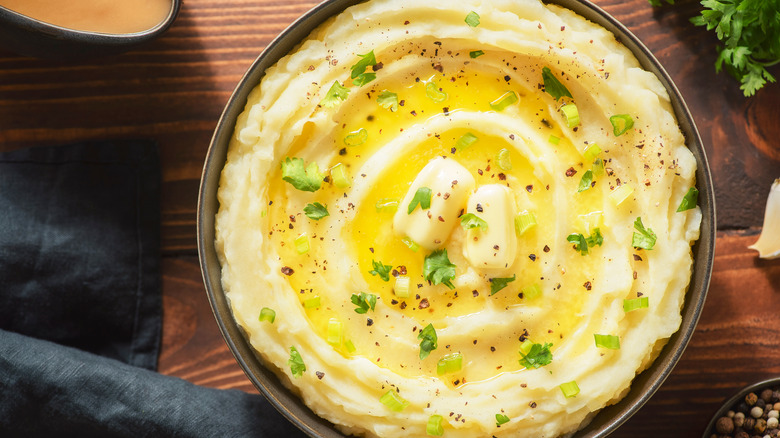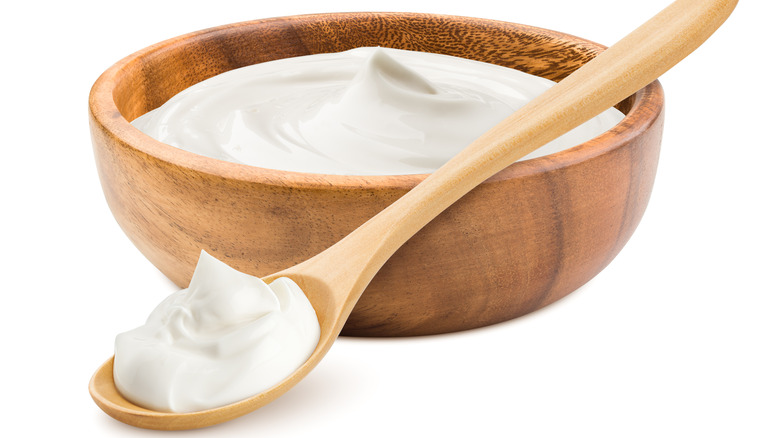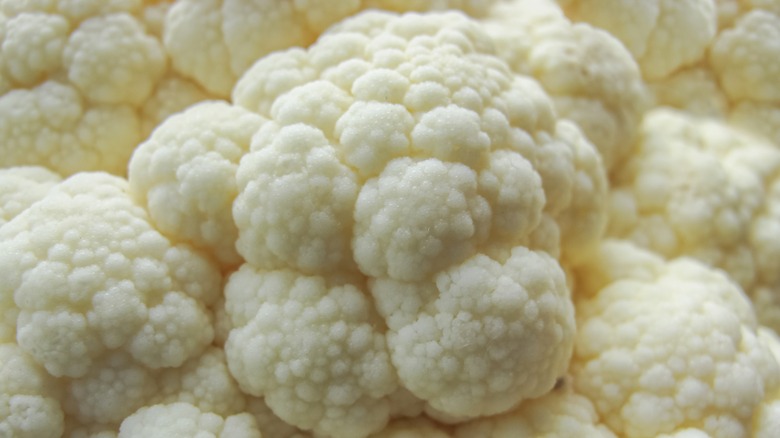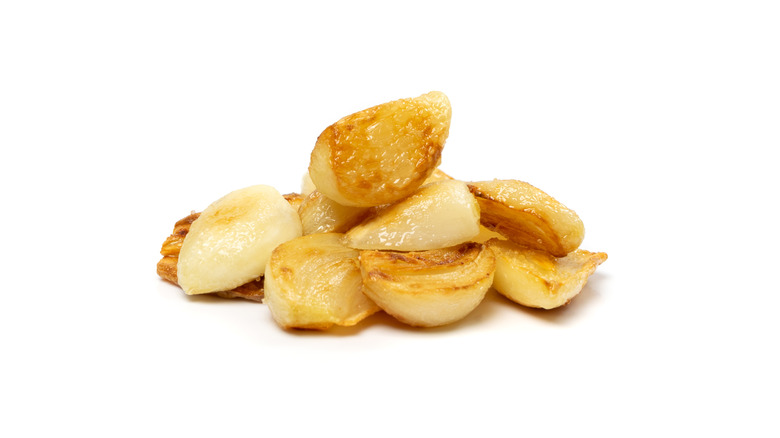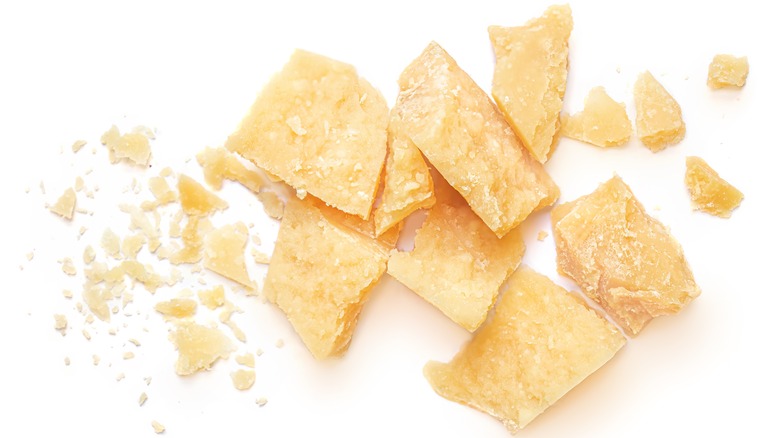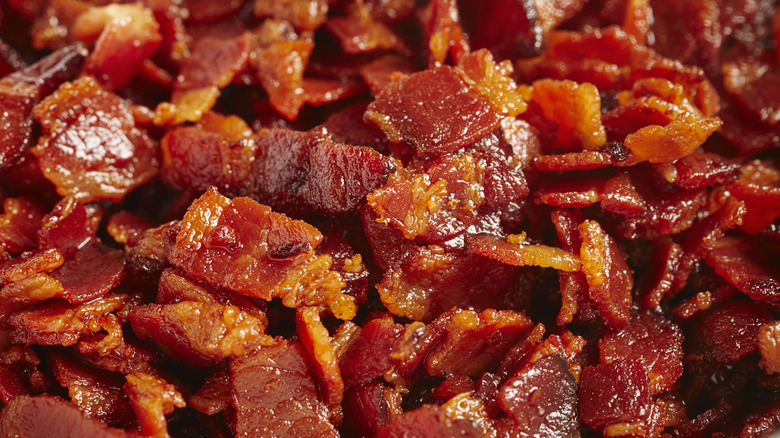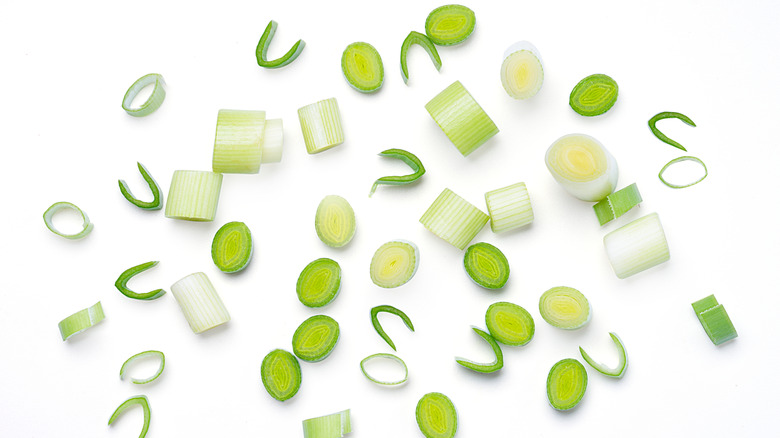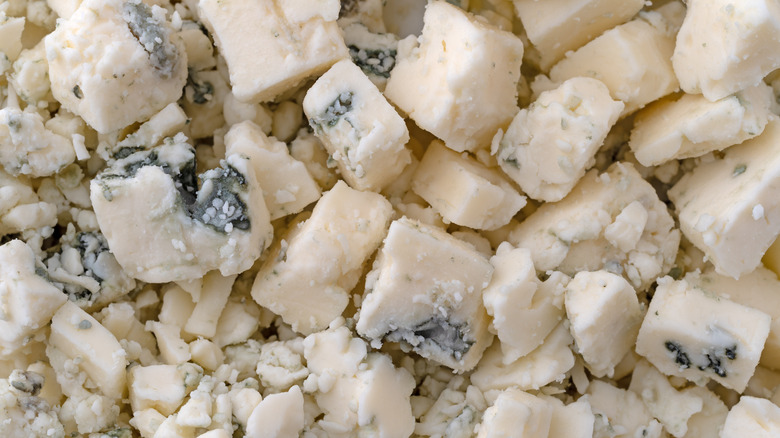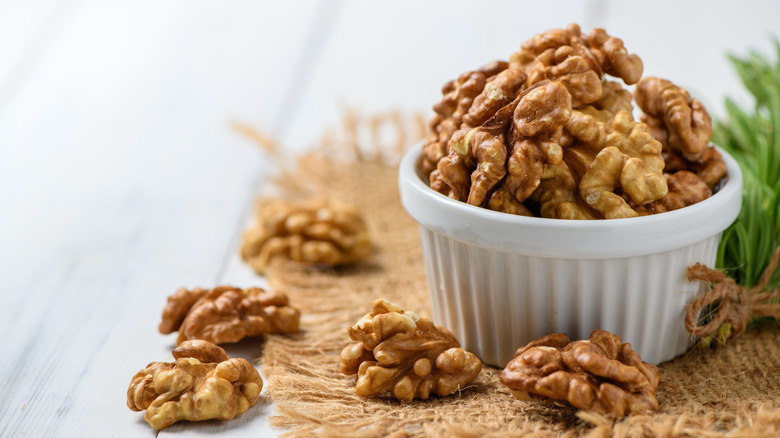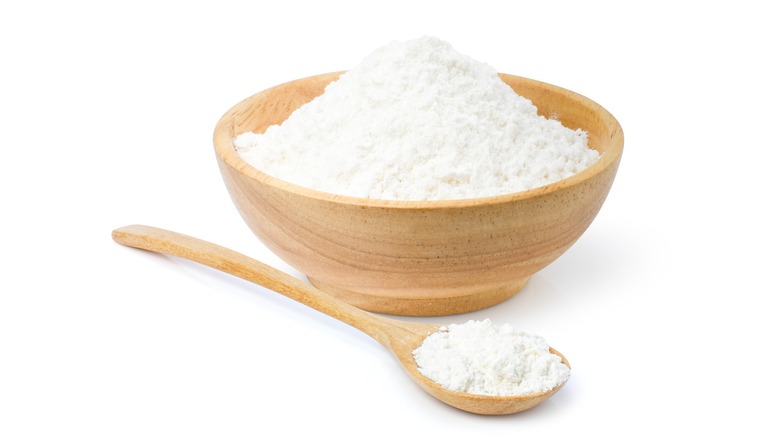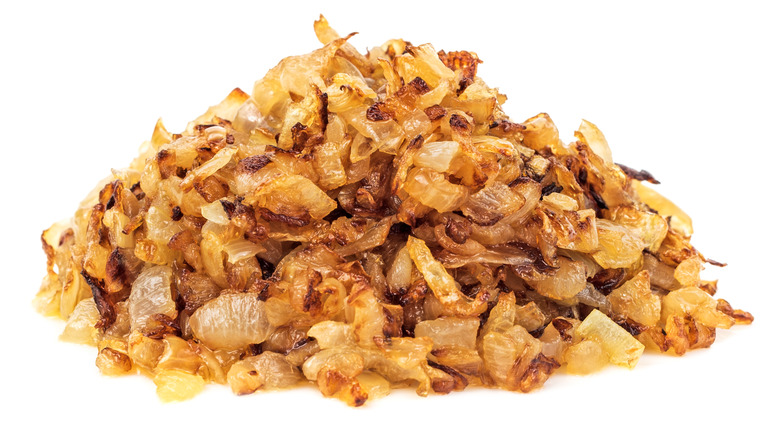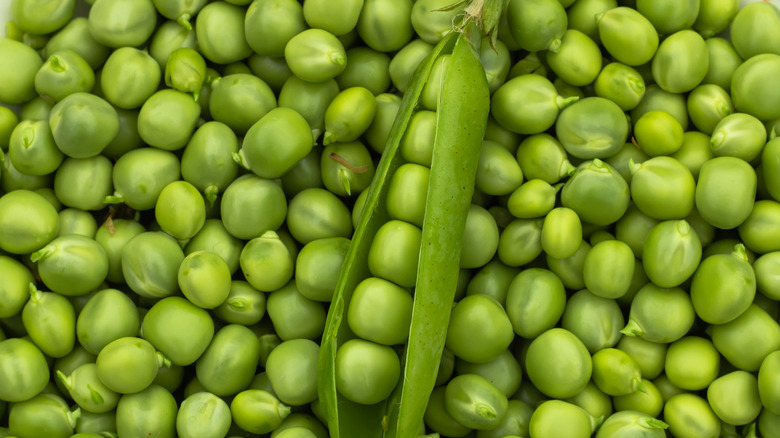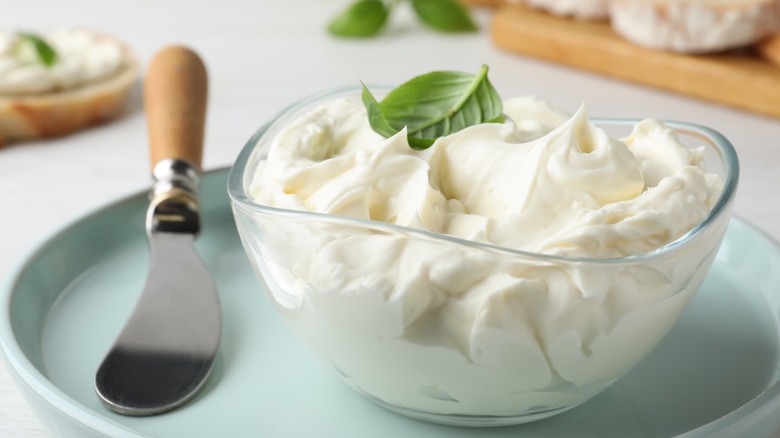12 Ingredients To Boost The Texture Of Mashed Potatoes
When it comes to classic comfort food, nothing hits the spot quite like a creamy, buttery, fluffy bowl of mashed potatoes. It's one of those crowd-pleasing dishes that most of us eat from cradle to grave, and it's easy to see why.
Mashed potatoes are nourishing, simple to make, easy on the wallet, and incredibly satisfying. Their mellow flavor also makes them highly versatile — they can be paired with everything from crispy pork chops or a fire-grilled steak to corned beef or fried chicken. The bottom line: Mashed potatoes are delicious and work well with just about any entrée you can imagine, so the ability to whip up a consistently tasty batch is always a great skill to keep in your culinary toolbelt.
Even though mashed potatoes are relatively simple to make, there's always room for improvement. Occasionally, you might find that the texture of your mashed potatoes needs a little boost. Maybe they're too thin and runny and you want a way to thicken them up. Or maybe you're just tired of following the same recipe and looking for easy ways to infuse extra flavor while adding some textural variation. Whatever the reason, there are plenty of ways to enhance this classic root vegetable with relatively minimal effort. Here are 12 ingredients you can use to boost the texture of your mashed potatoes.
Sour cream
There's a good chance you have some sour cream on hand in the fridge; it's a common kitchen staple. Thick and luscious, sour cream's signature tanginess can come in handy in a multitude of ways. There are seemingly endless approaches to put this stuff to good use, ranging from tacos to baked goods to beef stroganoff. But while sour cream is commonly used as a topping for baked potatoes, it may have never occurred to you to add it directly into a fresh batch of mashed potatoes.
The most important thing to remember is to add it at the very end of the cooking process, when the mashed potatoes are finished cooking. That way, the sour cream retains its dense consistency, which will help thicken your mashed potatoes. Sour cream adds a cool creaminess that can also help cut down on the saltiness of mashed potatoes if you accidentally added too much salt to the water that they were boiled in or otherwise over seasoned them. Beyond that, sour cream adds a silky, velvety texture and will also infuse the mashed potatoes with some tasty tanginess. Once you give this a whirl, you'll never go back.
Cauliflower
Like potatoes, cauliflower is a versatile vegetable that pairs well with a wide range of dishes. Also similar to potatoes, because cauliflower has such a mellow flavor profile, it can soak up tons of other flavors and act as a blank canvas to showcase a variety of different seasonings and sauces. But cauliflower has more going for it than mere versatility — it also happens to be one of the healthiest vegetables out there (via Healthline). Loaded with vitamins and minerals, cauliflower is rich in antioxidants as well, and can function as a low-carb alternative to grains and legumes.
Adding cauliflower to your mashed potatoes is an easy way to give them a nutrition boost while also adding some textural variation with less carbs. It doesn't require any special treatment — all you need to do is add fresh cauliflower to your salted pot of water to cook with your potatoes, then mash and season like you normally would. When the cauliflower is cooked through and tender, it will soften up and seamlessly mix with the mashed potatoes. If you want to keep some cauliflower bits intact for some textural variation, you can easily do that — just mash your potatoes in a separate bowl until they're smooth and creamy, mash your cauliflower separately but keep it a little chunkier, and then combine everything together.
Roasted garlic
If you're going to add texture to your mashed potatoes, you might as well make sure it's going to be flavorful.
When it comes to flavor, it's hard to beat fresh garlic. In its raw state, garlic has a sharp bite that straddles the line somewhere between invigorating and spicy. But when garlic is cooked, it takes on a much more nuanced flavor that's nutty and sweet. Chopping up some fresh cloves of garlic and simmering it in butter until it's fragrant and lightly golden is an easy way to add a wallop of flavor — along with some subtle texture — to your mashed potatoes.
If you truly love the flavor of garlic and want the texture in your mashed potatoes to be more pronounced, just chop the garlic into chunkier pieces before you cook it. That way, you can really bite down into the pieces in your mashed potatoes and experience it in all its full-bodied glory. Just be careful not to burn it: garlic takes on a bitter taste if browned too much. So, cook it over low heat and stop cooking the garlic right after it's yellowed and starting to lightly brown along the edges.
Another important point: Be sure to add a splash of olive oil to the pan with your butter before you start cooking. Adding some olive oil will prevent the butter from browning and burning too quickly, since butter burns faster than olive oil (via Simple Italian Cooking).
Grated parmesan cheese
While powdered parmesan has its time and place, in this context, grating some of the fresh stuff right off the brick is your best option. Fresh parmesan has a much deeper flavor than the powdered type, and it will add a nutty richness to your mashed potatoes that profoundly amps up the flavor in a significant way. Fresh grated parmesan can also help thicken up the potatoes and give them more body.
Beyond thickening, fresh grated parmesan will add some slight texture to the potatoes. Fresh parmesan cheese has a firmness to it that can work wonders when stirred into some mashed potatoes. There's nothing quite like taking a bite of creamy mashed potatoes and then tasting a little pop of fresh parmesan. Something to keep in mind: Because parmesan cheese is inherently salty, you want to take that into consideration. Salt is a necessary ingredient in hard cheeses like parmesan because it halts the growth of bacteria and also contributes to its strong flavor profile (via Business Insider). The bottom line: The more parmesan cheese you add, the less salt you should use to season your mashed potatoes to prevent it from becoming overly salty.
Bacon bits
Adding bacon bits to mashed potatoes is an easy way to imbue them with some smoky richness. When you cook your bacon strips, lay them on a wire rack over a sheet pan before putting it in the oven. Putting your bacon on a wire rack will allow the underside of the bacon to cook nice and crispy, since it won't be submerged in a pool of bacon fat the entire time. Be sure to leave some room between each slice and don't overlap them, so that the surface area of each piece can get direct exposure to the heat.
After the bacon's crispy, cooled off, and easy to handle, chop it up into bite-sized pieces. Be sure to save some of the bacon fat from the sheet pan. Adding a few drizzles of the bacon fat to your mashed potatoes will give them a flavorful, glorious sheen of rich smokiness. Sprinkle in the bacon bits and mix them in to taste — but don't overdo it. Adding too much will overpower the creaminess of the potatoes. You want just enough to add little bursts of smoky, meaty texture without overwhelming the potatoes. At the end of the day, potatoes should be the star of the show here. But bacon bits can play a supporting role that deliciously kicks the flavor up a notch while adding some lovely texture.
Green onions
Green onions are one of the most versatile vegetables around, so it's always a good idea to keep them on hand in the kitchen. They can be used to spruce up everything from fried eggs to burritos and sandwiches to salads. Green onions are often used as a topping for loaded baked potatoes — but have you ever thought of simply adding them into your potatoes when they're mashed? This is an easy, healthy, and affordable way to add some lovely flavor to your mashed potatoes while also adding some delicate texture to contrast with their soft creaminess.
After dicing your green onions into small, bite-sized pieces, you have a couple of options. You can add the raw diced green onions directly into your mashed potatoes while they're still warm, and the residual heat from the potatoes will soften the diced green onions up a bit. Another option is to briefly sauté your diced green onions in some butter to release their flavor a bit more — and then add the butter along with the green onions to your mashed potatoes. The flavor from the green onions will transfer into the butter, lending it a sharp, peppery flavor that works perfectly with creamy mashed potatoes. The small shards of green onions will add some bite to the silky potatoes, deliciously enhancing their texture.
Blue cheese
Blue cheese has a pleasantly pungent flavor that instantly adds a pop of cheesy richness to everything it touches. Typically used in everything from salads and dips to burgers and fried chicken sandwiches, blue cheese is a wonderful way to add some texture and zing to your mashed potatoes. It has a very distinctive taste that can easily overpower a dish, so it's important to be mindful of how much you're using. The best approach is to slowly add little crumbles to your mashed potatoes, tasting along the way.
Blue cheese adds a creamy, cheesy texture that pairs beautifully with potatoes. It has a semi-soft texture that's capable of remaining intact, but it can also melt a bit, depending on how warm your mashed potatoes are when you add it to the mix. If your blue cheese is in bigger chunks, it is best to break it into smaller crumbles so it can be more evenly distributed. This will also make it easier to add it slowly, so the flavor won't overwhelm the mashed potatoes. Like bacon and parmesan, blue cheese also has a high salt content, so it's also important to take that into consideration (via Very Well Fit).
Walnuts
This may seem a bit unconventional, but adding walnuts to your mashed potatoes comes with a number of tasty benefits. Walnuts tend to have a brittle texture that gives them a soft bite, which can lend a subtle texture to your mashed potatoes. Of course, you probably don't want to leave them whole, since walnuts are relatively large and could look quite clunky in your mashed potatoes — not to mention it might be kind of awkward to chew. Instead, try breaking them into bite-sized pieces.
Aside from their lovely texture, walnuts are jam-packed with vitamins and minerals (via Healthline). They are loaded with healthy omega-3 fatty acids (containing more than any other nut!) and are praised for their high level of antioxidants. If you really want to go the extra mile and knock it out of the park, try combining crumbled blue cheese and walnut chunks into your potatoes. The funky bite of blue cheese pairs perfectly with the delicate crunch of walnuts, and when they converge, some truly tasty magic happens. Not only are they a delicious combination, but they add contrasting textures of creaminess and crunchiness that work wonders on a batch of plain mashed potatoes.
Cornstarch
While cornstarch won't add any beneficial flavors to your mashed potatoes (it has a neutral taste), it can certainly help you achieve a desired texture. It is best dispatched when your mashed potatoes are a bit too soft and runny. Perhaps your potatoes were cut a bit too small and soaked up too much water, or maybe you just added too much milk and butter. However you ended up with runny potatoes, cornstarch is here to save the day; it's an easy way to thicken up lots of different dishes — including mashed potatoes.
It is vital, however, that you add the cornstarch in the proper way. Rather than just dumping in dry cornstarch powder, you'll want to thin it out with a little water first, into a slurry. The cornstarch slurry should have a smooth consistency, similar to cream. Once you've mixed up your cornstarch slurry, pour it directly into your mashed potatoes and give it all a good stir over low heat. You should see the mashed potatoes thicken up within a few minutes. If your mashed potatoes are still too thin, add a little more cornstarch slurry and continue stirring them over low heat until you've reached your desired level of thickness.
Caramelized onions
Caramelized onions are another easy, effective way to amp up the flavor and texture of your mashed potatoes. In this context, it is best to dice the onions into small squares rather than slicing them into strands. That way, the onions incorporate more seamlessly into the mashed potatoes, since strands will produce an awkward stringiness that doesn't really jive well with mashed potatoes. Diced caramelized onions will create some subtle texture, while also adding a slightly sweet nuttiness to the flavor that offers a nice contrast to the buttery saltiness of the mashed potatoes.
Once your onions are diced, add some olive oil and butter to a pan over medium heat. Add your onions when the butter is melted, continuing to stir over medium heat. Season with some salt and stir, then lower the heat once they've begun to lightly brown. Continue cooking over low heat until the onions take on a darker color and have achieved a sticky, almost jammy consistency. Making caramelized onions is quite easy but also time consuming, as it tends to take anywhere between 45 minutes to an hour.
To add extra flavor, you can deglaze the pan with chicken broth, balsamic vinegar, or marsala wine. Once your onions are caramelized, simply stir them into your mashed potatoes. The end result is a truly mouthwatering twist on mashed potatoes that really livens up both the texture and flavor.
Peas
Peas are often used as a side for mashed potatoes — but have you ever thought of fusing them together?
Typically done in the context of shepherd's pie (along with other fixings), the dish reveals a natural pairing deeply satisfying with the two ingredients blended together. Peas have a subtle, grassy sweetness that works hand-in-hand with mashed potatoes. They are also just the right size to create some slight textural variation. Peas often come in frozen bags at the grocery store, and while the directions typically instruct you to steam in the microwave, here's another suggestion.
To maximize their flavor, try warming them up in a skillet with some butter and garlic. Just be careful not to overcook them; since peas are small and delicate, they don't really require too much time over heat to warm up. You don't want to cook them until they're withered and shriveled — you just want to warm them up and give them a nice coat of garlicky butter. Once they're warm and ready, try giving them a little squeeze of fresh lemon to brighten up the flavor a bit, then stir them into your mashed potatoes and dig in.
Whipped cream cheese
Cream cheese is another common ingredient with a wide variety of uses. From toasted bagels to icing for cupcakes, cream cheese has a way of adding the perfect amount of richness to dishes both sweet and savory. While it may have never occurred to you to add a touch of cream cheese to your mashed potatoes, the truth is that it can add some extra oomph when it feels like something's missing.
One useful tip here is to buy whipped cream cheese instead of the kind that comes in brick form. Whipped cream cheese has a lighter airiness that will contribute a fluffiness and lightness that gives your mashed potatoes some extra luxuriousness — all while also contributing a tasty, rich tang.
If you really want to go above and beyond, try putting some of the earlier suggestions here to use as well; mix in some bacon bits and diced green onions, and now you're really cooking. The combination of whipped cream cheese with green onions and bacon will give your mashed potatoes a much deeper flavor and full-bodied texture bound to be an irresistible crowd-pleaser. Just be sure to add the whipped cream cheese one spoonful at a time; keep tasting along the way to achieve the perfect flavor and consistency.
